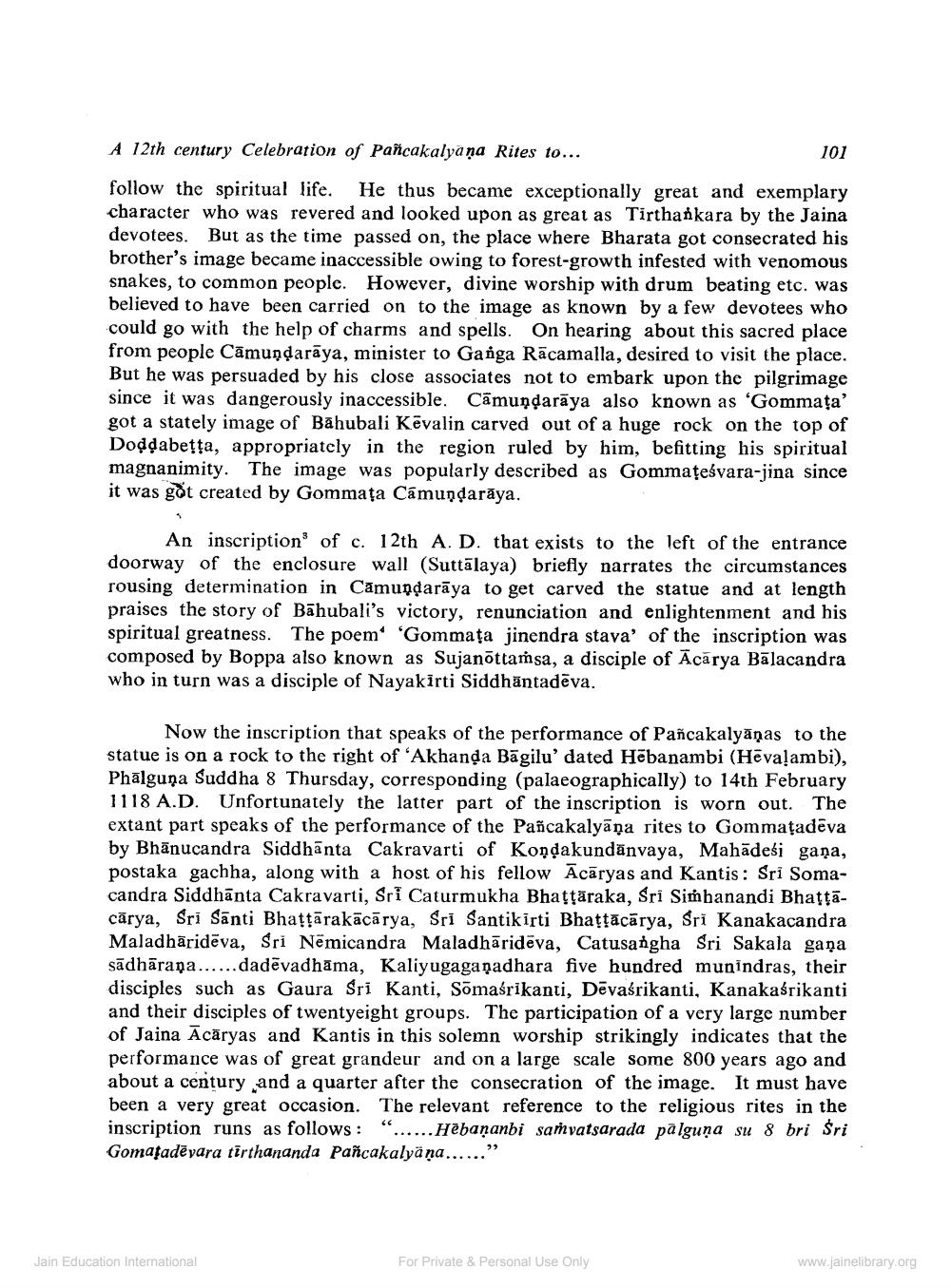________________
A 12th century Celebration of Pancakalyaņa Rites to...
101
follow the spiritual life. He thus became exceptionally great and exemplary character who was revered and looked upon as great as Tirthankara by the Jaina devotees. But as the time passed on, the place where Bharata got consecrated his brother's image became inaccessible owing to forest-growth infested with venomous snakes, to common people. However, divine worship with drum beating etc. was believed to have been carried on to the image as known by a few devotees who could go with the help of charms and spells. On hearing about this sacred place from people Cāmundarāya, minister to Gaiga Rācamalla, desired to visit the place. But he was persuaded by his close associates not to embark upon the pilgrimage since it was dangerously inaccessible. Cāmundarāya also known as 'Gommața' got a stately image of Bāhubali Kēvalin carved out of a huge rock on the top of Doddabetta, appropriately in the region ruled by him, befitting his spiritual magnanimity. The image was popularly described as Gommateśvara-jina since it was got created by Gommața Cámundarāya.
An inscription of c. 12th A. D. that exists to the left of the entrance doorway of the enclosure wall (Suttālaya) briefly narrates the circumstances rousing determination in Camundarāya to get carved the statue and at length praises the story of Bāhubali's victory, renunciation and enlightenment and his spiritual greatness. The poem 'Gommata jinendra stava' of the inscription was composed by Boppa also known as Sujanottamsa, a disciple of Ācārya Bālacandra who in turn was a disciple of Nayakirti Siddhāntadēva.
Now the inscription that speaks of the performance of Pañcakalyānas to the statue is on a rock to the right of 'Akhanda Bāgilu' dated Hēbanambi (Hēvaļambi), Phālguna Suddha 8 Thursday, corresponding (palaeographically) to 14th February 1118 A.D. Unfortunately the latter part of the inscription is worn out. The extant part speaks of the performance of the Pancakalyāṇa rites to Gommaţadeva by Bhānucandra Siddhanta Cakravarti of Kondakundānvaya, Mahādesi gana, postaka gachha, along with a host of his fellow Ācāryas and Kantis: Sri Somacandra Siddhānta Cakravarti, Sri Caturmukha Bhattāraka, Sri Simhanandi Bhattā. cārya, Sri Santi Bhattārakācārya, Sri Santikirti Bhattācārya, Sri Kanakacandra Maladhāridēva, Sri Nemicandra Maladhāridēva, Catusangha Sri Sakala gaņa sādhārapa...... dadēvadhama, Kaliyugagañadhara five hundred munindras, their disciples such as Gaura Sri Kanti, Somasrikanti, Dēvasrikanti, Kanakaśrikanti and their disciples of twentyeight groups. The participation of a very large number of Jaina Ācāryas and Kantis in this solemn worship strikingly indicates that the performance was of great grandeur and on a large scale some 800 years ago and about a century and a quarter after the consecration of the image. It must have been a very great occasion. The relevant reference to the religious rites in the inscription runs as follows: "......Hebananbi samvatsarada palguna su 8 bri Sri Gomagadēyara tirthananda Pancakalyäņa......"
Jain Education International
For Private & Personal Use Only
www.jainelibrary.org




